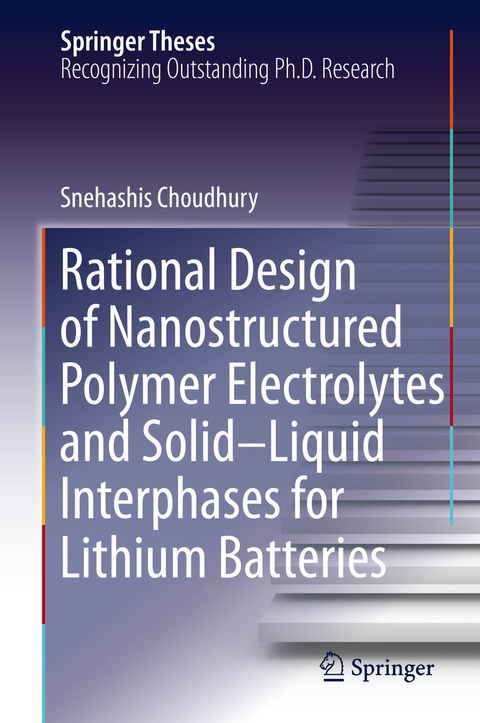
Rational Design of Nanostructured Polymer Electrolytes and Solid–Liquid Interphases for Lithium Batteries
Springer International Publishing (Verlag)
978-3-030-28942-3 (ISBN)
This thesis makes significant advances in the design of electrolytes and interfaces in electrochemical cells that utilize reactive metals as anodes. Such cells are of contemporary interest because they offer substantially higher charge storage capacity than state-of-the-art lithium-ion battery technology. Batteries based on metallic anodes are currently considered impractical and unsafe because recharge of the anode causes physical and chemical instabilities that produce dendritic deposition of the metal leading to catastrophic failure via thermal runaway. This thesis utilizes a combination of chemical synthesis, physical & electrochemical analysis, and materials theory to investigate structure, ion transport properties, and electrochemical behaviors of hybrid electrolytes and interfacial phases designed to prevent such instabilities. In particular, it demonstrates that relatively low-modulus electrolytes composed of cross-linked networks of polymer-grafted nanoparticles stabilize electrodeposition of reactive metals by multiple processes, including screening electrode electrolyte interactions at electrochemical interfaces and by regulating ion transport in tortuous nanopores. This discovery is significant because it overturns a longstanding perception in the field of nanoparticle-polymer hybrid electrolytes that only solid electrolytes with mechanical modulus higher than that of the metal electrode are able to stabilize electrodeposition of reactive metals.
Snehashis Choudhury is a postdoctoral researcher in the Department of Chemical Engineering at Stanford University. He received his PhD from Cornell University in 2018.
Chapter 1. Introduction.- Chapter 2. Self-Suspended Suspensions of Covalently Grafted Hairy Nanoparticles.- Chapter 3. A Highly Conductive, Non-flammable Polymernanoparticle Hybrid Electrolyte.- Chapter 4. Hybrid Hairy Nanoparticle Electrolytes Stabilize Lithium Metal Batteries.- Chapter 5. A Highly Reversible Room Temperature Lithium Metal Battery Based on Cross-linked Hairy Nanoparticles.- Chapter 6. Confining Electrodeposition of Metals in Structured Electrolytes.- Chapter 7. Soft Colloidal Glasses as Solid-State.- Chapter 8. Solid Polymer Interphases for Lithium Metal Batteries.- Chapter 9. Stabilizing Polymer Electrolytes in High-Voltage Lithium Batteries.- Chapter 10. Lithium Fluoride Additives for Stable Cycling of Lithium Batteries at High Current Densities.- Chapter 11. Designing Solid-Liquid Interphases for Sodium Batteries.- Chapter 12. Electroless Formation of Hybrid Lithium Anodes for High Interfacial Ion Transport.- Chapter 13. Designer Interphases For the Lithium-Oxygen Electrochemical Cell.
| Erscheinungsdatum | 06.10.2019 |
|---|---|
| Reihe/Serie | Springer Theses |
| Zusatzinfo | XVII, 230 p. 116 illus., 99 illus. in color. |
| Verlagsort | Cham |
| Sprache | englisch |
| Maße | 155 x 235 mm |
| Gewicht | 529 g |
| Themenwelt | Technik ► Elektrotechnik / Energietechnik |
| Technik ► Maschinenbau | |
| Schlagworte | Dendrite Growth • dendrite-induced short circuit • electrode-electrolyte interphase • electrodeposition measurement • hairy nanoparticle • Lithium-Ion Battery • multiscale modeling of ion transport • nanoparticle-polymer hybrid electrolyte • soft colloidal glasses |
| ISBN-10 | 3-030-28942-7 / 3030289427 |
| ISBN-13 | 978-3-030-28942-3 / 9783030289423 |
| Zustand | Neuware |
| Haben Sie eine Frage zum Produkt? |
aus dem Bereich


